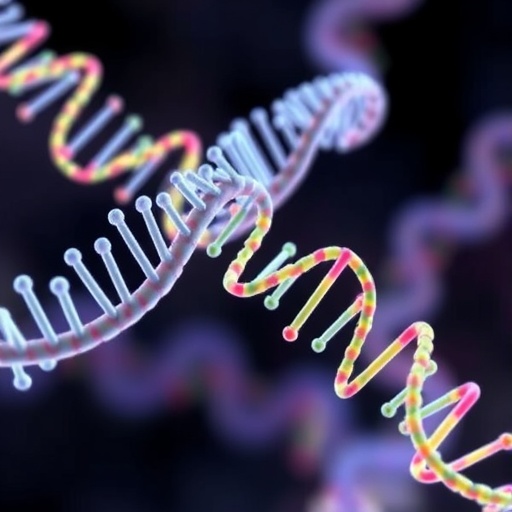In recent years, the enigmatic world of long non-coding RNAs (lncRNAs) has captured the fascination of molecular biologists and geneticists alike. Unlike messenger RNAs which serve as blueprints for protein synthesis, lncRNAs perform regulatory roles without coding for proteins themselves. Although thousands of lncRNAs have been cataloged in the human genome, deciphering their precise modes of action has remained an elusive challenge in modern biology. Now, a groundbreaking study published as the cover story in the journal Cell Genomics unveils novel mechanistic insights into how lncRNAs orchestrate gene regulation with unprecedented coordination.
An international consortium of researchers led by Drs. Hua-Sheng Chiu and Sonal Somvanshi from Baylor College of Medicine, in collaboration with teams from Ghent University, Tsinghua University, and other key institutions, has developed a sophisticated computational platform named BigHorn. This machine-learning tool leverages flexible pattern recognition to predict lncRNA binding sites on DNA and identify their target genes. By moving beyond traditional sequence-matching strategies, BigHorn captures the nuanced “elastic” interactions characteristic of lncRNAs within the cellular milieu, enabling a far more accurate mapping of lncRNA-DNA crosstalk.
Previous studies of lncRNAs have mostly focused on isolated examples and lacked mechanistic depth, leaving a significant knowledge gap regarding their biological relevance and functionality. The current work highlights a paradigm-shifting discovery: many lncRNAs simultaneously engage in dual-level regulation, controlling not just transcriptional activity but also the post-transcriptional stability and translation of their target mRNAs. This duality points to a tightly coupled regulatory circuit, where lncRNAs act as molecular chaperones that govern both gene expression initiation and the fate of the resultant transcripts in a coordinated manner.
.adsslot_K2O5beLkEB{width:728px !important;height:90px !important;}
@media(max-width:1199px){ .adsslot_K2O5beLkEB{width:468px !important;height:60px !important;}
}
@media(max-width:767px){ .adsslot_K2O5beLkEB{width:320px !important;height:50px !important;}
}
ADVERTISEMENT
The team’s use of BigHorn on an expansive dataset encompassing over 27,000 human tissue and cancer samples unveiled hundreds of such coordinated interactions across various cell types. The implications are vast, suggesting that lncRNAs contribute a sophisticated layer of gene expression fine-tuning that is particularly critical in diseases marked by gene dysregulation, such as cancer. This intricate regulation likely enables cancer cells to maintain robust control over gene networks that fuel their survival and proliferation.
To exemplify this regulatory mechanism, the researchers zeroed in on the lncRNA known as ZFAS1, which has been implicated in multiple cancer types due to its elevated expression levels. BigHorn predicted that ZFAS1 interacts with a broad spectrum of genes; most notably, it regulates the oncogene DICER1 at two pivotal junctures. DICER1 encodes an RNAse crucial for generating microRNAs—small RNA molecules that exert widespread control over mRNA stability and translation. Experimental validation revealed that ZFAS1 not only enhances transcription of the DICER1 gene but also shields its mRNA from degradation, thereby tightly synchronizing DICER1 expression with lncRNA levels.
Moreover, this study expands our understanding of lncRNAs beyond their previously assumed fragmented functions, positioning them as integral nodes in cohesively wired gene networks. Their ability to synchronize transcriptional and post-transcriptional gene regulation offers an elegant solution to the complexity of cellular control, especially in dynamic pathological contexts. The dual regulatory role might also provide mechanisms allowing cells to swiftly adapt gene expression outcomes to environmental cues, developmental cues, or stress signals.
Central to the success of this work is BigHorn’s innovative computational methodology. Traditional bioinformatics tools largely depended on strict nucleotide sequence complementarity, often missing the subtlety and conformational flexibility with which lncRNAs interact with chromatin. By employing machine learning techniques sensitive to “elastic” binding patterns, BigHorn achieves a remarkable predictive accuracy that faithfully mirrors biological reality. This advancement sets a new benchmark for future studies seeking to unravel non-coding RNA functions.
Beyond cancer, the findings carry broad implications for developmental biology, aging, and complex diseases. As lncRNAs show tissue-specific expression and are implicated in diverse physiological processes, the discovery of their coordinated regulatory roles opens avenues to decode molecular mechanisms underlying cell fate determination and organismal homeostasis. Researchers now have a powerful tool and conceptual framework to investigate how lncRNAs sculpt gene expression landscapes in both health and disease.
BigHorn is made publicly accessible through the openrna.org platform, inviting the scientific community to explore lncRNA-DNA interactions across organismal systems. By democratizing access to this resource, the authors hope to catalyze novel discoveries that could translate into innovative therapeutic strategies. The interdisciplinary collaboration behind this project exemplifies how computational power, combined with experimental validation, accelerates our grasp of complex genomic regulation.
This landmark study was supported by robust funding from multiple agencies including CPRIT, the European Union’s Horizon 2020 program, the National Cancer Institute, and key institutions across the globe. It leverages data generated from thousands of human samples, illustrating the power of big data in decoding molecular machineries. The contributions of numerous investigators across genetics, molecular biology, oncology, and computational science disciplines reflect the multidisciplinary nature essential to tackling such biological complexity.
In summary, this research heralds a new era in RNA biology, where lncRNAs are appreciated not merely as passive transcripts but as dynamic regulators capable of synchronizing gene expression at multiple regulatory layers. The implications for understanding cellular regulation, particularly in cancer, are profound. As more lncRNAs are studied through the lens of coordinated regulation, we anticipate transformative insights that will reshape molecular medicine and biotechnology.
Subject of Research: Animals
Article Title: Coordinated regulation by lncRNAs results in tight lncRNA-target couplings
News Publication Date: 7-Jul-2025
Web References: https://openrna.org/, http://dx.doi.org/10.1016/j.xgen.2025.100927
References: Cell Genomics, DOI 10.1016/j.xgen.2025.100927
Keywords: Life sciences, Cell biology, Computational biology, Genetics, Molecular biology, Organismal biology, Physiology
Tags: advancements in lncRNA researchBaylor College of Medicine researchBigHorn machine-learning toolcollaborative research in genomicscomputational biology in geneticsgene expression regulation mechanismslncRNA binding sites predictionlncRNA-DNA interactionslong non-coding RNAsmechanistic insights in gene regulationmolecular biology of lncRNAsrole of lncRNAs in gene expression





